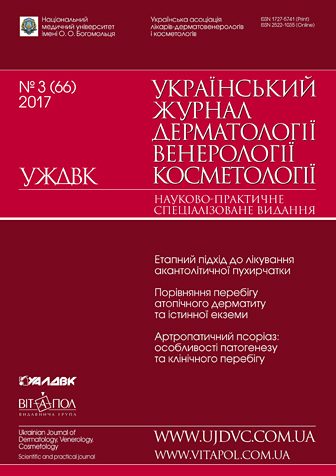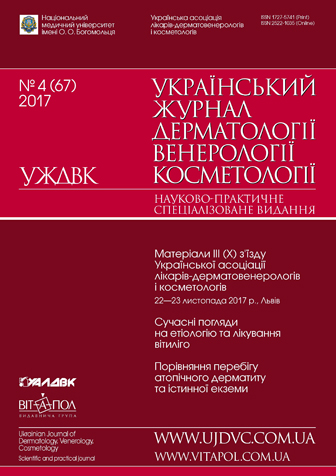- Issues
- About the Journal
- News
- Cooperation
- Contact Info
Issue. Articles
¹3(66) // 2017

1. Scientific researches
|
Notice: Undefined index: pict in /home/vitapol/ujdvc.vitapol.com.ua/en/svizhij_nomer.php on line 76 New phased approaches in the therapy of acantholytic pemphigusV.P. Fedotov, V.A. LytvinovZaporizhzhya State Medical University |
|---|
Materials and methods. 30 patients with acantholytic pemphigus aged from 51 till 72 years were under the observation; the duration of the disease was from 3 weeks to 3 months. Methods of investigation: general clinical, daily monitoring of arterial pressure, cardiointervalmetry with the device Cardiolab, oxidative modification of proteins, metabolism of nitric oxide. Fourtime study was conducted: before the treatment, after 2—3 weeks of taking high doses of glucocorticosteroids (stage I), after 1.5—2 months of the therapy, when hormone doses were reduced (stage II) and 3—4 months after discharge from the hospital, when the patient received therapy with maintenance doses of hormones (Stage III). At the first stage of therapy, in addition to glucocorticosteroids, the use of two antihypertensive drugs, intravenous drip of rehambyrin, platelet aggregation inhibitors, probiotics, hepatoprotectors (Essentiale-H), ATP and cocarboxylase as intramuscular injection, sodium chloride solution iv, antibiotics, potassium preparations, calcium, antacids. At the second stage, patients received the same drugs, but in slightly reduced doses, one antihypertensive drug, hepabene was prescribed from hepatoprotectors. At the third stage, it is necessary to use antihypertensives (Àmlodipine), diuretics (Triphas), hepatoprotectors, anticoagulants, vitamins, potassium preparations. At this stage, we recommend taking statins (Roxera).
Results and discussion. Patients with acantholytic pemphigus had a statistically significant increase of glucose values, AlAt, AsAt, cholesterol, especially LNSH, triglycerides, a decrease in total protein. In the future, at all stages of treatment, the tendency to normalization was noted, but only triglycerides, LDL cholesterol, glucose, total protein demonstrated full correction at the third stage. When studying the variability of the heart rate, we revealed pathological changes in the vegetative balance towards sympathotonia, which were multidirectional at different stages of treatment. During the 24-hour monitoring of arterial pressure, an increase of patients with an insufficient nightly fall of non dippers pressure over CAT was found, and an increase in patients with non dippers and night peakers before treatment. The study of oxidative modification of proteins has established a high level of endogenous intoxication in patients with AP, even at the third stage of treatment. While studying the metabolism of NO in patients with AP before the treatment, a high level of NO synthase was established, which caused pathological effects of NO, and during the treatment with hormones its level droped sharply, especially at the third stage.
Conclusions. Therapy of patients with AP should be performed in 3 stages depending on the doses of glucocorticosteroids using both traditional drugs and some new ones, based on the study of liver function, biochemical parameters, heart rate variability, monitoring of blood pressure, metabolism of NO, oxidative modification of proteins. The administration of anabolic and sedatives is not recommended.
Keywords: pemphigus, biochemistry, protein, NO-synthase, treatment, preparations, glucocorticosteroids, stages.
![]() To download
To download
full version need login
Original language: Ukrainian
2. Scientific researches
|
Notice: Undefined index: pict in /home/vitapol/ujdvc.vitapol.com.ua/en/svizhij_nomer.php on line 76 Analysis of factors influencing the development of acne severe formsM.E. Zapolskiy1, M.Ì. Lebed³uk1, N.B. Prokofyeva1, D.V. Ivanov3, |
|---|
Materials and methods. The study included 74 patients with acne of different severity. All patients completed special questionnaires that allowed to determine the factors that provoked the disease. Serum cortisol, dehydroepiandrosterone sulfate, free testosterone, sex hormone binding globulin were determined as well.
Results and discussions. The main clinical manifestations of severe forms of acne are nodularcystic abscessed forms, nodularcystic acne with necrosis, nodularcystic acne with asymmetric lesion, acne with a tendency to keloid formation, fulminant acne. The main trigger factors of severe forms of the disease are psychoemotional stress, irrational cosmetic manipulation, and the prolonged use of topical antibiotics. The most significant endocrine fluctuations were revealed in the analysis of the level of dehydroepiandrosterone sulfate in patients with severe forms of acne. Important prognostic criteria for assessing the severity of acne in men are the rates of dehydroepiandrosterone sulfate and sex hormone binding globulin, in women — the levels of cortisol and free testosterone.
Conclusions. Interpretation of the majority of diagnostic markers of severe forms of acne should be carried out taking into account individual characteristics of the organism, concomitant endocrine and somatic pathology.
Keywords: acne, severe forms, trigger factors, dihydroepiandrosterone sulfate, cortisol, free testosterone, sex hormone binding globulin.
![]() To download
To download
full version need login
Original language: Russian
3. Scientific researches
|
Notice: Undefined index: pict in /home/vitapol/ujdvc.vitapol.com.ua/en/svizhij_nomer.php on line 76 Features of disbiosis correction of oral cavity in patients with diabetes mellitus 2 typeO.P. Stupak1, A.P. Levitsky2, M.Y. Niedzielskó1, M.O. Dudchenko11 HSEI «Ukrainian Medical Stomatological Academy» Poltava |
|---|
Materials and methods. Under our supervision were 59 patients fasting blood sugar diabetes mellitus 2 type at the age of 45—65 years (men — 24, women — 35). All the patients had diabetes mellitus middle degree, in stage of sybcompensation, fasting blood sugar 8—12 mmol/l. The patients were taken divided 2 groups: compare group, which received basic treatment in accordance with protocol (Actovegin on 1 tablets 3 time in day, AEvit on 1 tablets 1 time in day; injection — Milgama on 2,0 ml/day, Etamzilat on 2,0 ml/day, Nicotinic Acid on 1,0 ml/day; Mildronat on 5,0 ml/day), and the main group, which received the drug of Kvertulin (on 1 tea spoon 4 time in day after eating). Therapeutic effect of Kvertulin evaluated the content of glucose in the blood, plasma levels of biochemical markers of inflammation: concentration of malone dyaldegyde and activity of elastase. On the degree of microbial contamination was tried on activity of urease, nonspecific immunity status was assessed by activity of lysozyme. In terms of relative of urease and lysozyme expected of degree of disbiosis on the method of prof. A.P. Levitsky. Antioxidant activity was assayed by activity of catalase and the antioxidant-prooksidantny index.
Results and discussion. In patients with diabetes mellitus 2 type in the plasma of blood elevated levels of biochemical markers of inflammation (malone dyaldegyde, elastase) and microbial contamination (urease) while reducing the activity of lysozyme and catalase. In patients with diabetes increases disbiosis degree 7—9 times, under the influence of the basic treatment is reduced by 29 %, and when combined with Kvertulin — on 87 %. Kvertulin increases the activity of catalase and the antioxidant-prooksidantny index in 3.0–3.5 times.
Ñonclusions. Use in complex treatment of the patients of the drug Kvertulin significantly improves biochemical parameters, reduces disbiosis and increases the level of protection.
Keywords: Diabetes mellitus, disbiosis, inflammation, enzymes, Kvertulin.
Notice: Undefined index: attach in /home/vitapol/ujdvc.vitapol.com.ua/en/svizhij_nomer.php on line 177
Original language: English
4. Scientific researches
|
Notice: Undefined index: pict in /home/vitapol/ujdvc.vitapol.com.ua/en/svizhij_nomer.php on line 76 Clinical and pathogenetical comparison of atopic dermatitis and true eczemacourseO.D. AleksandrukIvano-Frankivsk National Medical University |
|---|
Materials and methods. 129 adults with atopic dermatitis and chronic true eczema were examined. Clinical diagnostically important features were compared as well as clinical effectiveness of the treatment, secretion of serumIgE, IFN-g, and IL4 in course.
Results and discussion. It was determined that diagnostics criteria of atopic dermatitis were often presented in patients with true eczema but significant difference of minor criteria presence was of great difference in differential diagnosis. Two different, from pathogenesis point of view, variants of atopic dermatitis and true eczema were determined based on serum IgE level: one with hightotal serum IgE and relation between IL 4 and the disease severity, the other with normal IgE level and dependence on the disease severity on IFN-g secretion. Due to crossover increase of IFN-g synthesis in patients with IgEdependent course of disease the common duration of in — patient treatment phase is longer. Out-patient follow-up of such patients requires continuation of systemic antihistamine treatment.
Conclusions. Our data shows that both atopic dermatitis and true eczema in adults have common clinical and pathogenesis features and two slightly different variants of course. IgE-dependent variant for both diseases is connected with longer duration of inpatient management and necessity to continue systemic antihistamine treatment during early follow-up.
Keywords: atopic dermatitis, true eczema, interleukin, treatment.
![]() To download
To download
full version need login
Original language: Ukrainian
5. Scientific researches
|
Notice: Undefined index: pict in /home/vitapol/ujdvc.vitapol.com.ua/en/svizhij_nomer.php on line 76 Arthropathic psoriasis: concepts of pathogenesis and clinical courseO.O. SyzonDanylo Halytsk³y Lviv National Medical University |
|---|
Materials and methods. In total 178 patients with AP against the background of psoriasis and 12 patients without complains of osseous-articular impairment underwent clinical laboratory and additional examinations (DXR, USE, MRI) in 2014—2017. The impact of AP and treatment course on the life quality was assessed with questionnaires DLQI, PDI, PASE, CPDAI, Zung and ÐÀS² index. The total protein content and transaminase activity was determined with SIMKO Ltd reagents set, amylase, cholesterol, urea, thymol test, bilirubin levels were assessed with application of BIO-Lachema- Test (BRNO, AMS, CHOL-150, ÒG, Urea-450, TTT-150, Bil st), serological indexes (level RF, C-reactive protein, ASL-O) were identified with qualitative and quantitative methods. The condition of articulation joints and soft tissues was assessed with MRI with the apparatus logiq 3, Aloka SSD-3500 SX ProSound.
Results and discussion. In most cases, at AP joint damage occurs simultaneously with psoriasis. The following pathognomonic AP signs are determined: simultaneous psoriatic skin and nails damage; asymmetric mono or oligoarthritis predominantly of peripheral joints especially associated with the hands DIJs damage; osteolysis; negative reaction to rheumatoid factor. The primary localization of a pathological joint process in AP patients in areas of increased traumatism of tendon-ligamentous apparatus and its relationship with psoriatic nails damage is substantiated pathogenetically. The characteristic presence of periarthritis (enteritis, tendovaginitis confirmed by MRI, USD diagnostics), especially at the initial disease stages, has been determined. In most cases, AP is combined with the presence of nails pathology being a warning of the development of joint articular psoriasis disease. A number of radiological AP features are noted, which include: asymmetry of damages, radial type of hand joints arthritis, weak manifestation of subchondral osteoporosis and combination of osteolysis with osteosclerosis, ultimate narrowing of distal pharyngeal epiphyses of fingers, ossification of diaphysis periost, distal and proximal joints ankylosis of the same finger, zygapophysial joints of cervical vertebra, mosaic inflammation of joints and ossification of ligaments, unilateral sacroiliitis, and the presence of rough syndesmophyte.
Concllusions. Ap is a problem for theoretical and practical medicine solution of which requires multidisciplinary approach to administer differentiated pathogenetic treatment.
Keywords: arthropathic psoriasis, clinical and instrumental examinations fatures.
![]() To download
To download
full version need login
Original language: Ukrainian
6. TO HELP PRACTICING PHYSICIANS
|
Notice: Undefined index: pict in /home/vitapol/ujdvc.vitapol.com.ua/en/svizhij_nomer.php on line 76 Modern concept on the problem of onychomycosis. Market analysis of the topical antifungal agentsB.G. Kogan1, E.A. Verba2 |
|---|
Keywords: onychomycosis, methods of treatment and prevention, new formulations, amorolfine, nail lacquer, Amoderm Neo.
List of references: 1 Î.Î. Bogomolets National Medical University, Kyiv
2 Dr. Bogomolets Institute îf Dermatology ànd Cosmetology, Kyiv
![]() To download
To download
full version need login
Original language: Russian
7. PHARMACOTHERAPY IN DERMATOLOGY AND VENEREOLOGY
|
Notice: Undefined index: pict in /home/vitapol/ujdvc.vitapol.com.ua/en/svizhij_nomer.php on line 76 Acne vulgaris: modern concepts on etiology, pathogenesis and treatmentN.Yu. ReznichenkoCI «Zaporizhzhya Regional Skin and Venereal Clinical Hospital» of Zaporizhzhya Regional Council |
|---|
Keywords: acne vulgaris, papularpustular form, treatment, Zerkalin®.
![]() To download
To download
full version need login
Original language: Ukrainian
8. PHARMACOTHERAPY IN DERMATOLOGY AND VENEREOLOGY
|
Notice: Undefined index: pict in /home/vitapol/ujdvc.vitapol.com.ua/en/svizhij_nomer.php on line 76 Innovative combined treatment of onycho and dermatomycosis in patients of different age groups. New experience of medication clinical application in practice of dermatologistB.G. Kogan1, E.A. Verba21 Î.Î. Bogomolets National Medical University, Kyiv |
|---|
Keywords: mycoses, dermatomycoses, onychomycoses, antifungal agents, combined therapy, terbinafine, Terbinorm, spray, tablets.
![]() To download
To download
full version need login
Original language: Russian
9. PHARMACOTHERAPY IN DERMATOLOGY AND VENEREOLOGY
|
Notice: Undefined index: pict in /home/vitapol/ujdvc.vitapol.com.ua/en/svizhij_nomer.php on line 76 A differentiated approach to topical therapy for steroidsensitive dermatosesL.A. BolotnaKharkiv Medical Academy of Postgraduate Education |
|---|
Keywords: ñhronic inflammatory dermatoses, external therapy, glucocorticosteroids, mechanism of action, basic therapy, emollients.
![]() To download
To download
full version need login
Original language: Russian
10. PHARMACOTHERAPY IN DERMATOLOGY AND VENEREOLOGY
|
Notice: Undefined index: pict in /home/vitapol/ujdvc.vitapol.com.ua/en/svizhij_nomer.php on line 76 Psoriasis combined pathology. Îverview of advanced treatment methods for dermatosisM.E. Zapolskiy1, M.M. Lebediuk2, S.V. Nerubaschenko1, A.V. Dobrovolska3, D.Ì. Zapolska31 Regional Dermatovenerologic Dispensary, Odesa |
|---|
Keywords: psoriasis, asthenization, hepatotoxicity, immune suppression, detoxicant, «Hepargin».
![]() To download
To download
full version need login
Original language: Ukrainian
11. CLINICAL CASE STUDIES
|
Notice: Undefined index: pict in /home/vitapol/ujdvc.vitapol.com.ua/en/svizhij_nomer.php on line 76 Peculiarities of modern epidemiology, clinical course and therapy of molluscum contagiosumV.G. KravchenkoMedical Consulting Center «Medipol», Poltava |
|---|
Keywords: molluscum contagiosum, epidemic analysis, atypical course, destructive treatment methods.
![]() To download
To download
full version need login
Original language: Ukrainian
12. CLINICAL CASE STUDIES
|
Notice: Undefined index: pict in /home/vitapol/ujdvc.vitapol.com.ua/en/svizhij_nomer.php on line 76 Stevens—Johnson syndrome in the patient of with severe recurrent course of subcorneal pustular dermatosis Sneddon—WilkinsonL.D. Kaliuzhna1, N.V. Turyk21 P.L. Shupyk National Medical Academy of Postgraduate Education, Ministry of Healthcare of Ukraine, Kyiv |
|---|
Keywords: subcorneal pustular dermatosis (Sneddon—Wilkinson disease), Stevens—Johnson syndrome, recurrent course.
![]() To download
To download
full version need login
Original language: Ukrainian
13. CLINICAL CASE STUDIES
|
Notice: Undefined index: pict in /home/vitapol/ujdvc.vitapol.com.ua/en/svizhij_nomer.php on line 76 Clinical case of congenital erythema telangiectaticum — Bloom’s syndromeD.S. Polishchuk1, 2, S.I. Polishchuk2, V.S. Komarnytska21 National Pirogov Memorial Medical University, Vinnytsya |
|---|
Keywords: Bloom’s syndrome, congenital erythema telangiectaticum.
![]() To download
To download
full version need login
Original language: Ukrainian
14. CLINICAL CASE STUDIES
|
Notice: Undefined index: pict in /home/vitapol/ujdvc.vitapol.com.ua/en/svizhij_nomer.php on line 76 Ñase of sclerosing lymphangitis of the penisV.E. Tkach, M.S. VoloshynovychSHEI «Ivano-Frankivsk National Medical University», Ivano-Frankivsk |
|---|
Keywords: sclerosing lymphangitis, differential diagnosis.
![]() To download
To download
full version need login
Original language: Ukrainian
15. Reviews
|
Notice: Undefined index: pict in /home/vitapol/ujdvc.vitapol.com.ua/en/svizhij_nomer.php on line 76 The 5 most Frequently Asked Questions (FAQ) from our patients about acneC. DiehlUniversitá Degli Studi Guglielmo Marconi, Rome, Italy |
|---|
Keywords: Acne, diet, hygiene, makeup, camouflage, acne scars, frequently asked questions.
Additional:
Dr. Christian Diehl, Department of Dermatology, Universitá Degli Studi Guglielmo Marconi
Via Plinio, 44, 00193, Rome, Italy. Å-mail: chdiehl@hotmail.com
Notice: Undefined index: attach in /home/vitapol/ujdvc.vitapol.com.ua/en/svizhij_nomer.php on line 177
Original language: English
Log In
Notice: Undefined variable: err in /home/vitapol/ujdvc.vitapol.com.ua/blocks/news.php on line 51


